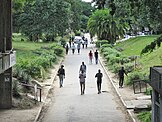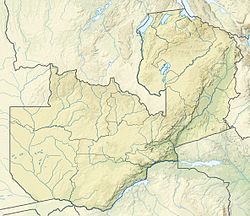Lusaka
Mwalusaka | |
|---|---|
From top and left to right: Central business district of Lusaka with FINDECO House visible; Kafue Roundabout and surroundings, University of Zambia Main Campus, Cathedral of the Holy Cross, ZANACO head office, Society Business Park, Cairo Mall, Lusaka National Museum exhibition | |
| Nickname: LSK | |
| Coordinates: 15°25′S 28°17′E / 15.417°S 28.283°E | |
| Country | |
| Province | Lusaka Province |
| District | Lusaka District |
| Established | 1905 |
| City status | 25 August 1960 |
| Government | |
| • Type | Mayor-council government |
| • Mayor | Chilando Chitangala (PF) |
| Area | |
| • Capital city | 360 km2 (140 sq mi) |
| Elevation | 1,279[3] m (4,190 ft) |
| Population (2010 Census) | |
| • Capital city | 1,747,152[1] |
| • Estimate (2020) | 2,731,696[4] |
| • Metro | 2,238,569 |
| Demonym | Lusakan |
| Time zone | UTC+02:00 (Central Africa Time) |
| • Summer (DST) | (Not Observed) |
| Area code | 0211[5] |
| HDI (2018) | 0.664[6] Medium |
| Website | www |
Lusaka (/luːˈsɑːkə/ loo-SAH-kə) is the capital and largest city of Zambia. It is one of the fastest-developing cities in southern Africa.[7] Lusaka is in the southern part of the central plateau at an elevation of about 1,279 metres (4,196 ft). As of 2019[update], the city's population was about 3.3 million, while the urban population is estimated at 2.5 million in 2018.[8] Lusaka is the centre of both commerce and government in Zambia and connects to the country's four main highways heading north, south, east, and west. English is the official language of the city administration, while Bemba and Nyanja are the commonly-spoken street languages.

The earliest evidence of settlement in the area dates to the 6th century AD, with the first known settlement in the 11th century. It was then home to the Lenje and Soli peoples from the 17th or 18th century. The founding of the modern city occurred in 1905 when it lay in the British protectorate of Northern Rhodesia, which was controlled by the British South African Company (BSAC). The BSAC built a railway linking their mines in the Copperbelt to Cape Town and Lusaka was designated as a water stop on that line, named after a local Lenje chief called Lusaaka. White Afrikaner farmers then settled in the area and expanded Lusaka into a regional trading centre, taking over its administration. In 1929, five years after taking over control of Northern Rhodesia from the BSAC, the British colonial administration decided to move its capital from Livingstone to a more central location, and Lusaka was chosen. Town planners including Stanley Adshead worked on the project, and the city was built out over the subsequent decades.
Lusaka lost some of its status to Salisbury (now Harare in Zimbabwe) when the latter became the capital of the merged Federation of Rhodesia and Nyasaland in 1953, but regained it when it was named the capital of newly independent Zambia in 1964. A large-scale building programme in the city followed, including government buildings, the University of Zambia and a new airport. Wealthy suburbs in Lusaka include Woodlands, Ibex Hill and Rhodes Park. Large-scale migration of people from other areas of Zambia occurred both before and after independence, and a lack of sufficient formal housing led to the emergence of numerous unplanned shanty towns on the city's western and southern fringes.
- ^ Central Statistical Office. "Population and Demography of Zambia". Retrieved 20 September 2020.
- ^ City of Lusaka Website Archived 20 April 2012 at the Wayback Machine
- ^ Airport altitude, http://climexp.knmi.nl/ Retrieved 7 March 2015
- ^ Central Statistical Office. "Population and Demographic Projections". Retrieved 20 September 2020.
- ^ "Zambia". International Telecommunication Union. 14 November 2019. Archived from the original on 15 September 2017. Retrieved 15 July 2021.
- ^ "Sub-national HDI – Area Database – Global Data Lab". hdi.globaldatalab.org. Retrieved 13 September 2018.
- ^ "Africa's fastest-growing cities". Deutsche Welle. Retrieved 12 April 2021.
- ^ "Zambia Population 2020 (Live)". worldpopulationreview.com. Retrieved 28 April 2020.









